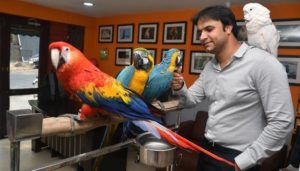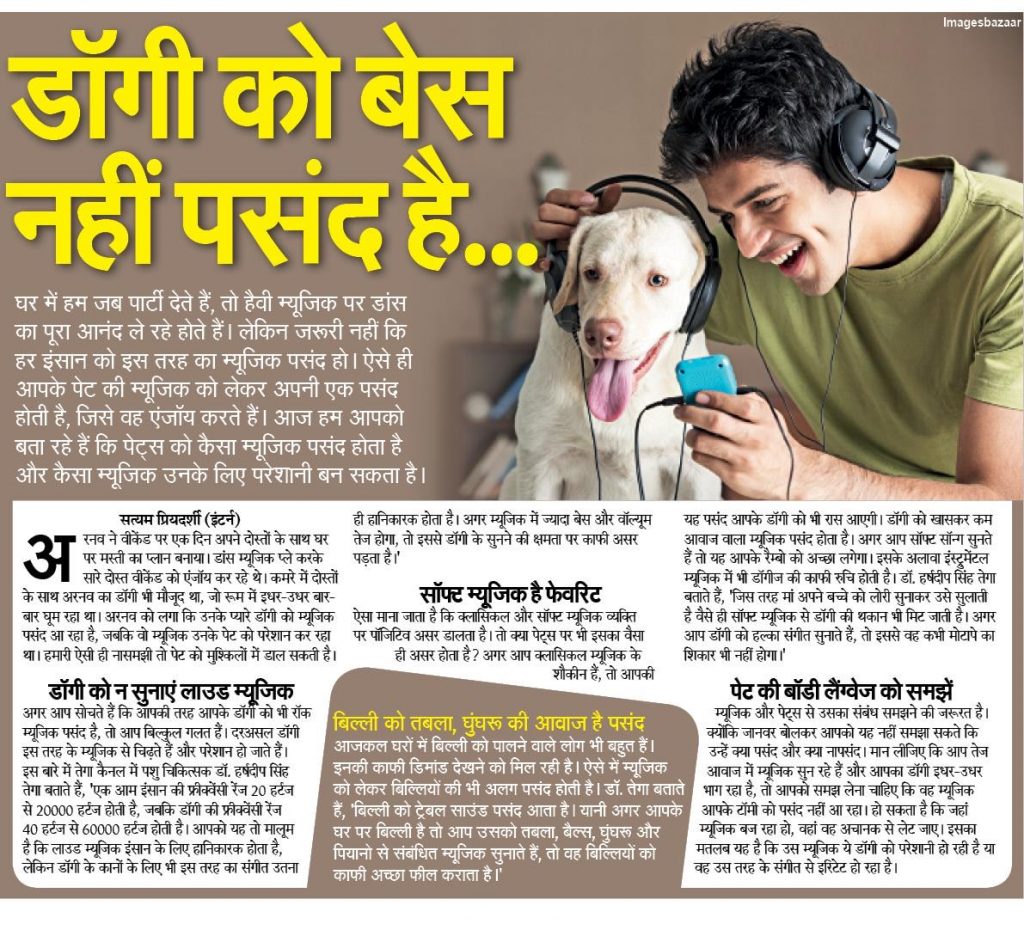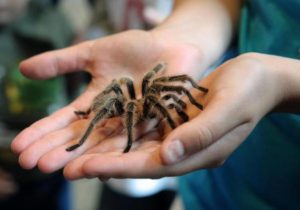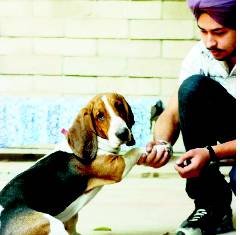
Meet bulldogs on nebulisers, iguanas under UV light and tarantulas in a box
Some weeks ago, in a horrific incident in Chennai, two pet Rottweilers mauled their owner’s 68-year-old mother to death. The Rottweilers were usually kept away from the owner’s elderly parents, but that one slip proved fatal.
The Rottweiler is a large dog that is restricted or banned in several countries because it has been known to attack people, but India does not yet require owners to get licences for dangerous pets. And if you think the Rottweiler is an inappropriate pet, you haven’t yet heard of what else pet-crazy owners are likely to keep — from St. Bernards to monkeys and Persian cats to iguana, the list is long and eccentric. Exotic dog breeds, however, top the scales.

Harshdeep Singh, who runs a kennel that specialises in foreign dog breeds. | Photo Credit: R.V. Moorthy
Enthusiasm for animals is all very well, but our understanding of what makes an appropriate pet is still way off the mark. Every animal and breed is attuned to a certain environment and ecosystem, but all too often pets are seen merely as status symbols or ‘time-pass’ or something the “kids threw a tantrum for”. Adopted with little research, wrong pets make the relationship less about animal love and more a chore churlishly executed.
Take, for instance, Beagles. Because of their size, they are often considered ideal for apartments. “Beagles are originally hunter dogs used to sniff out prey,” says Shravan Krishnan, Chennai-based animal rights activist. “They actually need a lot of space to move around freely and simulate the hunting atmosphere.”
Great Danes, on the other hand, who we think need acres of space, are really great dogs for flats. “People imagine they need to run a lot,” says Krishnan. But Danes tend to suffer from multiple orthopaedic problems like arthritis and hip dysplasia when over-exercised, especially at a younger age, as well as having comparatively low stamina.“They are a laidback, lazy breed and require little exercise,” Krishnan says.
The ideal pet would be dogs suited for tropical climates. And, as Krishan says, preferably breeds that have been around for a long time. Dogs like Chippiparai, Rajapalayam and Kanni are native breeds, well-suited to the climate and conditions.
Breeder ‘rejects’
Pia Sharma is adoption coordinator at the Friendicoes animal shelter in Delhi. Recently, they found a pair of St. Bernards abandoned on the New Delhi-Karnal highway. Neither dog can walk and Pia surmises that they are either breeder ‘rejects’ or have been abandoned by owners who found they could not take care of them. “It is not easy to take care of St. Bernards, and when they can’t walk, it’s another minus point for owners,” says Sharma, adding, “How do you convince somebody that no matter how many ACs you turn on, a St. Bernard isn’t going to be happy in Delhi?”
- St. Bernard – ₹15,000-₹25,000
- Husky – ₹25,000-₹40,000
- Cavapoo – ₹45,000-₹90,000
- Coton de Tulear – ₹45,000 onwards
- Cavachon – ₹90,000-₹1,30,000
- Green iguana – ₹15,000 onwards
- Tarantula – ₹10,000
- American bull frog – ₹30,000
- Shetland pony – ₹4 lakh onwards
- Ostrich – ₹2 lakh
Neither is an Akita, a breed that originates from the mountainous north of Japan, which became especially popular after the movie Hachi: A Dog’s Tale. But there’s nothing to stop people with disposable incomes from going out and buying these breeds. Pia suggests that breeders take up the burden of explaining to buyers the responsibilities and pitfalls of owning these animals.
There are many pet-owners who do have the time and the money to go all out for their unusual animals. They not only install extra air-conditioners but also have large spaces and an army of helpers to exercise and groom their pets. But in many cases, so-called animal lovers have pets that are ill-treated, malnourished and unhealthy. Shelters across metropolitan cities are full of victims of irresponsible ownership.
Suparna Ganguly, co-founder of Bengaluru-based CUPA (Compassion Unlimited Plus Action), says their shelter is packed to the rafters with pedigree dogs. “Once a puppy becomes an adult, reality sets in. The dogs are either kept in cruel confinement or abandoned,” she says.
The problem, however, might not so much be the breed as ignorance. As Theodore Baskaran, author of The Book of Indian Dogs, says, “All the dogs we see, whether Spaniels, Labradors, or German Shepherds, come from very cold countries, but they have adapted to Indian conditions.”
Foreign breeds do adapt to Indian climate in a couple of generations, but it is important to maintain congenial conditions, size of habitation, how their coats are maintained, and the diets they are given. “Dogs are not vegetarians. People forget that vegetarianism is a human value and cannot be imposed on dogs,” says Baskaran.
Thankfully, pet owners are also a changing breed now. The demand for breeds like Huskies, St. Bernards and Akita has dropped considerably over the past couple of years, with owners aware of the pitfalls that come with owning them. They’re greatly susceptible to extreme shedding, drooling, hygroma, as well as temperamental problems — all associated with the climate.
Know your pets
Those who can afford to buy high-end pedigreed animals or foreign breeds are now better educated and more aware of what their animals need. They have a clear idea of what they can provide and what breed they want, and seem patient and willing to learn about upkeep and habits.
In April 2016, the Centre banned the import of foreign breeds of dogs for breeding and commercial purpose, making exceptions only for imports intended for defence services, the police forces, and R&D organisations that have government approval.
However, dog breeds already within the country can still be bred and sold, and that’s where the foreign breeds that are sold here legally come from. Harshdeep Singh, owner of Tegha Kennel in Gurugram, for example, says he only sells dogs who have been in the country for at least 21 generations.
Singh specialises in breeding several foreign breeds, including hybrids, and says his buyers approach him after doing the research. “They know non-shedding dogs, ones good for apartments, ones that don’t need regular walks, have low-protein diets or require minimal visits to the vet, and so on.” And science seems to be keeping up with owner demands. Allergies, for example, are a major reason for abandoning pets. So now you have hypoallergenic pet breeds that won’t set you sneezing.
Breeds like Coton de Tulears, Cavapoo and Cavachons are all the rage, says Singh. Maya Ray of Faridabad was very clear that she wanted a dog that wouldn’t set off her allergy but she was also sure she wanted a furry pet.
Trendsetters
She narrowed down on Malteses, Havaneses and Shi Tzus before finally settling on a Coton de Tulear. But she admits that there are difficulties here too. “Its coat gets knotted very easily, and sometimes it becomes impossible to brush the fur. So, come summer, we will have to strip her fur completely.”
Then there are the ‘trend pets’, animals picked up because they look cute in a film or because a famous filmstar owns one. There was a rash of buyers for spotted dogs after 101 Dalmatians came to town, and pugs became popular after starring in a telecom company ad. But Pugs, like Boston Terriers and French bulldogs, need extra care. BAOS or brachycephalic airway obstructive syndrome is a condition that affects short-nosed dogs, putting them through extreme respiratory difficulty especially in dry climes. Earlier, vets would suggest putting down the pet, but now Mithun Mehta gives his French bulldog, Leo, a dose of nebuliser every couple of weeks. “It takes more than half an hour for each sitting, but it’s something we’re willing to do, and it’s worth it. The nebuliser saved Leo’s life,” says Mehta.
There are many owners like Mehta who are prepared to take the detailed checklists that Singh prepares for customers. He also conducts behavioural counselling sessions before the pet is handed over. Owners of dogs with BAOS who live in areas with harsh, dry winters are told that nebulisers are a must, whether the dog has breathing difficulties or not. “The chances of their trachea collapsing is very high, and this must be avoided,” he says.
But Sharma is afraid that these training and counselling sessions only work for those who already possess a certain amount of skill with dogs, and want to improve them. It’s also about whether people can afford the cost of such a workshop. “Someone who can’t afford these sessions but still wants a pet dog will go ahead and get one. They’re the ones who need to be reached and trained,” she points out.
And in any case dogs are often abandoned or ill-treated for reasons that have little to do with health. Often, for example, parents will call a shelter about their child’s dog or just abandon it after their teenager leaves home. Often, the dog will face the family’s wrath if it reacts to mistreatment. “If you have a Pit bull in a home with young children and they pull the dog’s tail, it will obviously snap,” Sharma says, “and the Pit bull is then abandoned for being aggressive.”
States like Haryana and Punjab buy pets for another reason — dog-fights. Although illegal under the Prevention of Cruelty to Animals Act, 1960, dog-fights are still rampant in some areas here. And there is high demand for breeds like the Kurdish Kangal or Pit bull.
Animal love
Says Sharma: “We’ve just rescued a Pit bull and from the scars we know it must have been used in dog-fighting.” Bets in these fights run up to lakhs and crores, and Singh says that if a dog is grievously injured in a fight, the owner just leaves it to die.
The fascination for pets is impossible to understand fully. Humans are unique in the animal kingdom in wanting or needing to create close bonds with creatures of other species. American biologist Edward O. Wilson suggested that it might have been an evolutionary advantage to be close to other animals. Psychologists have pointed to how humans “infantilise” pets, giving them the role of children; fulfilling the human need to nurture and get unconditional love from creatures dependent on us.
But how much love will you get from a lizard? Nevertheless, there you are. People are getting progressively more inventive about what pet company they choose. Iguana, for instance, are touted as the next best thing. S.A. Suhail, who owns Hyderabad’s Fur N Feathers pet store, says people want off-beat pets. “A large number of people are opting for reptiles. They find it easier to care for an iguana than, say, a dog,” he says. It could also be the desire for “new things,” he adds, as an afterthought.
Praveen Chikoti owns, among more plebeian creatures such as swans and geese, iguana, frogs, and over 20 breeds of spiders, both venomous and non-venomous. He says he has had cats and dogs all his life and “wanted something unusual now.”
 Chikoti is aware that reptiles, amphibians and insects require special enclosures and habitats to keep them comfortable and safe. “I need to make sure I match the exact climactic conditions that they’re brought from. So, for example, in the winters we use UV lights, bulbs, and room-heaters to keep the surroundings warm,” he says. He even has a staff of 25 trained people who work round-the-clock to keep his pets comfortable.
Chikoti is aware that reptiles, amphibians and insects require special enclosures and habitats to keep them comfortable and safe. “I need to make sure I match the exact climactic conditions that they’re brought from. So, for example, in the winters we use UV lights, bulbs, and room-heaters to keep the surroundings warm,” he says. He even has a staff of 25 trained people who work round-the-clock to keep his pets comfortable.
What about the law?
Actually, it is illegal under the Indian Wildlife Protection Act (WPA), 1972, to own Indian wildlife as pets. “Any animal protected under the schedules of the WPA, and categorised as ‘scheduled wildlife,’ cannot be kept as a pet in India,” confirms Jose Louies, Chief of Wildlife Crime Control Division, Wildlife Trust of India. “The term ‘animal’ here also encompasses birds, reptiles, amphibians, and even eggs.” So, Indian owners resort to buying foreign wildlife breeds, imported by breeders and dealers who take care of the paperwork. This opens up a whole new and frightening scenario that nobody seems to be talking about yet.
There’s a creature commonly found in large pet shops across the country, the red-eared slider turtle native to South America. It’s a favourite because of its tiny size when young. “But they grow very fast,” says Krishnan, “and within a couple of years, they outgrow the tank. Owners invariably dispose of them by releasing them into nearby ponds or lakes.” But the turtles are an invasive species; they take over the waterbody’s ecosystem and destroy the local species. This is true of some exotic fish as well, often flushed down the pot when the owner can’t take care of them. Or exotic breeds of lizards and snakes released into the wild when they become unmanageable. “We also don’t know whether these exotics coming to the country have been quarantined, or subjected to proper testing. It creates a larger biological threat, where they might carry harmful bacteria, or spread diseases,” adds Louies.
Until now, nobody has started to worry about these problems, and maybe the numbers are not large enough yet. But as the trend grows, legislation might have to play catch-up if native species and ecosystems are to be kept safe. Meanwhile, the next big thing in pets might not be a polka-dotted Dalmatian but a Malagasy rainbow frog.
http://www.thehindu.com/society/has-our-fetish-for-unusual-pets-gone-overboard/article22643124.ece
 ‘Awww, cute’ may be the way you react to your neighbourhood pooch when it’s out on its walk and wagging its tail at you. But if you own an exotic breed such as a Great Dane, Terrier or St. Bernard, it’s not just about their cuteness; your own style quotient can improve by several notches.
‘Awww, cute’ may be the way you react to your neighbourhood pooch when it’s out on its walk and wagging its tail at you. But if you own an exotic breed such as a Great Dane, Terrier or St. Bernard, it’s not just about their cuteness; your own style quotient can improve by several notches.
Such dogs get to live in a world of their own. Often, they are pampered silly. Exotic dogs often have their pick of fancy, imported pet food, indulge in dog spas with skin care, grooming and pedicure, are adorned with jewellery and have a personal doctor and trainer. People take great pains to make the dog comfortable, no expense spared.
When it comes to exotic breeds, you can get one from ₹25,000 to ₹25 lakh and more. But the best way to own a dog is to adopt one. However, people who have specific dogs in mind can opt for exotic breeds. Foreign dogs have different physical traits and are known for their unique features.
What’s your dog type?
Before you go for an exotic dog breed, figure out the type of dog you want, based on your personality and lifestyle. Dogs with similar characters are grouped under one of the seven categories (hound, working, gundog, terrier, utility, pastoral and toy) according to the UK’s kennel club standards.
The hound breeds were originally used for hunting (either by sight or smell). The dogs under this (scent) category include beagles and bloodhounds. The sight hounds are breeds such as greyhound and whippet. Hounds require a lot of exercise. They are aloof but trustworthy.
Gundogs, on the other hand, were originally trained to hunt live game or retrieve or rescue wounded animals. They include breeds such as retrievers, spaniels and setters.
These dogs require plenty of exercise and attention. They are considered the most intelligent among their kind. Pastoral dogs, such as collies and samoyeds, are herding dogs and are naturally protected from severe weather conditions.
Toy-dogs are small companion or lap dogs. They do not require much exercise and are usually overprotective of their owners. Chihuahuas, Maltese, Pomeranians, and pugs are some of the breeds in this group. People usually choose dogs based on physical qualities such as the size or length of their hair.
Certain breeds are hypoallergenic (won’t trigger allergies) and are extremely good with children while others have the strong prey drive and are difficult to control.
Your choice
For instance, the gundog breeds, which were basically trained to hunt game, exhibit aggressive behaviour such as excessive barking and hyperactivity, which can be undesirable if there are toddlers around. However, if you are more into outdoor activities such as biking and hiking, these might be the right companions for you.
If you are looking for dogs that guard, you could opt for working breeds that were originally meant to guard. Great Danes and St. Bernards are natural guard dogs and are wary of all outsiders.
Climatic conditions, where you live and how much time you can spend with your dog are also major factors to be considered while choosing a dog.
The purchase price of an exotic breed may vary depending on multiple factors.
The cost
According to Manikanta Grandhi, owner of Mansan Kennel, Bangalore, “Reputation of the breeder, bloodlines (parentage) of the dogs, breed type (pure or hybrid), dog-show winners (within their bloodlines) and the dog breed itself (rare or common) would define the cost of a dog.”
According to Grandhi, the English bulldog, an iconic British breed, is considered one of the most expensive dogs globally. Pure-bred English bulldogs range between ₹1 lakh and ₹2.5 lakh in India.
It is better to go for dogs whose bloodlines are known since one gets a clearer picture about their health and temperament. Such dogs are bred by registered breeders who have the requisite clearances. Exotic rare breeds could cost more than the regular exotic ones, and this could also be based on colour and availability. Among English bulldogs, the colours blue, grey and white are rare and therefore cost more, about ₹4 lakh and above.
According to Harshdeep Tegha of Tegha Kennels, Gurgaon, rare dogs such as Puli and Komondor, of the pastoral group, sell at around ₹11 lakh. These dogs are for people who can spend time with them. They are large and powerfully built, with a dense coat or fur, and usually have a life-span of less than 10 years.
If you are looking for smaller-sized exotic breeds, then Shiba Inu could be suitable. This dog is active and has quick, light movements. It costs around ₹11 lakh and has a life-span of over 10 years. Other exotic varieties such as Bolognese, Leon Berger, Golden retriever, Alaskan malamute and Maltese are frequently purchased and range between ₹2 lakh and ₹6 lakh.
Care for them right
Almost all exotic dogs have weak immune system due to the change of environment from their natural habitat. Hence, they are prone to various problems such as excessive hair shedding, ragged breathing, skin disease and frequent allergic reactions.
Grandhi of Mansan Kennels observes that most exotic dogs suffer from canine parvovirus (CPV), particularly in the first few weeks of the litter’s growth, but if cared for right, they will grow up healthy. That said, indigenous dog breeds are increasingly gaining attention as they have high immunity.
Thus, regular vaccination, frequent health check-ups, eye test, skin care, shampoo, proper diet and exercise are required for the canines to adapt and adjust to their new environment. It is advisable to purchase quality food for your dog, especially at the early stages of their life, when they have to eat three or four times a day.
“These dogs need proper grooming and have to be taken to the spa from time to time. The animals are bought by people who are willing to take care of them and ready to spend on their maintenance if need be,” says Harshdeep Tegha.

The craze to own exotic dog breeds, the more expensive, the better, is growing by the day with owners willing to pay several lakhs for that prized pedigree pet. It’s about status, of course, but does it also constitute animal rights violation? Gargi Gupta reports
Caucasian Ovcharkas are large dogs found mostly, as the name indicates, in the Caucasus, a mountain range that occupies the narrow strip of land between the Black and Caspian Seas. They are large dogs, with dark shaggy coats giving them added bulk and protecting them from the intense cold of the highlands and valleys where they are generally used to guard sheep.
In his third-floor, 2,000sq ft apartment in  west Delhi, Brutus, a year-old Ovcharka pup, couldn’t be further away from his natural habitat. His heavy paws, made for trudging on snow and rough terrain, have to contend with the smooth granite of the plush apartment; it’s cold alright thanks to the central air-conditioning but there’s no way that Brutus can go outside in the searing heat. For company, there’s his master Manmohan Singh Jolly, his wife and son and his two minders. The natural aggression of this ancient dog breed means very few people will venture near Brutus. “Every morning Brutus will bark when the minder, who looks after him, comes to work every day and yet thinks the minder is an intruder,” laughs Jolly.
west Delhi, Brutus, a year-old Ovcharka pup, couldn’t be further away from his natural habitat. His heavy paws, made for trudging on snow and rough terrain, have to contend with the smooth granite of the plush apartment; it’s cold alright thanks to the central air-conditioning but there’s no way that Brutus can go outside in the searing heat. For company, there’s his master Manmohan Singh Jolly, his wife and son and his two minders. The natural aggression of this ancient dog breed means very few people will venture near Brutus. “Every morning Brutus will bark when the minder, who looks after him, comes to work every day and yet thinks the minder is an intruder,” laughs Jolly.
For the Jollys, Brutus is a prized possession – they paid Rs5 lakh for him. “My father saw him at the shop and fell in love with him. We’ve always had large dogs. We had a Great Dane earlier and a Dalmatian. There’s only one other Ovcharka we know of in Delhi,” says son Prabhjyot.
The craze to own exotic breeds, the more expensive, the better, is growing by the day, says Harshdeep Singh Tegha, who runs Tegha Kennels in Delhi. Tegha Kennels offers and has sold dog breeds from all across the world, the most expensive being the Tosa Inu or Japanese Mastiff (Rs35 lakh), Scottish Deerhound (Rs17 lakh) and Black Russian Terrier (Rs18 lakh). All three are dogs from cold climates, dogs bred for specific tasks – the Japanese Mastiff used for guarding sheep, the Scottish Deerhound for hunting and the Black Russian Terrier for military work – and not quite geared to be the house-trained domestic pet for whom, frequently, the most energetic and exciting thing in the day is a romp around the park.
And then there is Bangalore-based breeder Sathish S who set a record when he paid a crore to buy a Korean Dosa Mastiff. “I have been wanting these breeds for the past 20 years,” says Sathish, who has housed them in air-conditioned kennels to help them acclimatise to the hot Indian climate. Sathish who also runs a pet shop in Bangalore called Cadabom’s Kennels, came under a lot of criticism some years ago for a Neapolitan Mastiff he bred; he nicknamed it Ghost and advertised it proudly as “the most prolific and heavily (sic.) wrinkled dog in the world”.
A memorandum from the animal husbandry department, dated December 2015, flags the dangers of this unchecked influx of exotic dog breeds. “In the recent past, there has been an alarming upsurge in the import of exotic and rare breed dogs from different climatic zones across the globe. Indiscriminate and sudden increase in import of dogs has led to creation of huge market for imported dogs in the country, while there are no guidelines/regulation regarding neutering, registration, breeding and sale of pet or commercial dogs…as these dogs are imported from various climatic conditions, adaptation of these animals to Indian conditions is not smooth.”
Dog lovers like Anant Ambani, industrialist Mukesh Ambani’s son, who have the resources to create home-like conditions for their pets – he owns an Alaskan Malamute, a large freight dog from the Arctic regions, and created a chilled section in his home. But not all are as lucky.
For many owners, the fascination with a prize pedigree pet wears off soon enough and they are abandoned at animal shelters. “Sometimes we get around five calls a day reporting an abandoned animal. Most of them are injured, bitten or ill – being so-called pedigreed they don’t have the skills to survive on the street. So you’ll find stray labradors running about in the market, or St Bernards along highways or great danes tied to railway tracks.
In the summers, the animal is usually tied to the gate, or left outside in the verandah, and when he barks, owners complain,” says Geeta Seshamani of Frendicoes-SECA, which has a home that takes in these abandoned animals and puts them up for adoption.
In the past three years, adds Seshamani, more people are coming to adopt or foster strays, old, handicapped or ill dogs. “We have been posting images of abandoned animals on our Facebook page and Twitter handles, and in many cases, we’ve been able to place them in good, caring homes. This is an optimistic development,” she says.
According to NG Jayasimha, managing director of NGO Humane Society International, a global animal rights advocacy group, what India needs is a law to regulate the pet trade. “The pet and pet supplies trade, which some estimate to be around Rs800 crore a year, is not regulated in India. There are no guidelines for breeding or sale of dogs. Dogs are often bred in unscientific ways leading to health problems like hip aplasia for labradors, breathing problems for pugs and so on. No pet shop gives a receipt for sale and different prices are quoted for the same breed,” he says.
Late last month, the Directorate General of Foreign Trade imposed a ban on the import of dogs for breeding – a move that will hurt breeders like Sathish S – but this might not be enough to check malpractices, says Seshamani. “Last year, the state government had formulated draft rules for dog breeding and selling and to regulate pet shops, which mandates registration of all sale of pets, installing a micro-chip with all identity and health details. But it is still to notify it,” she adds.
“Most people don’t make a realistic evaluation before they decide which dog breed to get for their homes,” says Lakshya Sawhney, who runs the pet-grooming service called Flying Fur in Delhi.
“Large breeds are an absolute misfit in apartments. Aggressive breeds can be dangerous if you have young children or too many strangers visiting. Don’t get hyperactive dogs if you have no time to exercise them regularly. In many cases, it’s the kids who insist and the parents buy them a dog, not realising how much care a dog requires. And then the trouble starts,” Sawhney adds.
Here’s hoping that aspiring dog owners will heed this advice.
 Dogs of race: The rich Indians are seeking the Kennel
Dogs of race: The rich Indians are seeking the Kennel
“Chiens de race : les riches Indiens cherchent la niche”
The Indians are discovering a passion for breeds: owning one has become a status symbol . But the country is not necessarily suitable for all breeds and some of these good doggies suffering under the local climate.
” Les Indiens se découvrent une passion pour les chiens de race : en posséder un est devenu un symbole de réussite sociale. Mais le pays n’est pas forcément adapté à toutes les races et certains de ces braves toutous souffrent sous le climat local.”

08:37 AM IST Dec 30, 2014 Mkrba area of Ahmedabad in a society of a 10-year-old is the example of courage. Sister of his half of the draw on 10 years of Kanchi saved a dog. Tegha kennel Director Harshdeep singh told about How to Handle a Dog Attack !
- Warding Off an Attack
- Defending and Protecting Yourself
- Handling the Aftermath
- Taking Precautions Against Attacks
Especially for joggers and runners, there is a danger of being completely blindsided, so that a dog attack is happening before you can even have a chance to try to avoid it. If you have enough time, the first line of defense is to let the dog attack something on you that isn’t you — for example, if you’re wearing a sweater, get your arm out of a sleeve and get that sleeve in the dog’s face. If the dog takes the bait, let it pull the sweater off, then slowly back out of the area. To the dog, it has just gotten hold of a piece of you, and this may distract it long enough for you to get to safety.
It’s probably good practice to always have something on you that you can use in this manner, whether it’s a sweatshirt tied loosely around your waist, a stick, or even a stuffed dog toy. If you can pull it off quickly enough, you can also use one of your shoes for this maneuver.
In all cases, remember to protect your face, chest, and throat. Also keep your hands in fists to protect your fingers. If you must be bitten, the safest place for it to happen is the shin or forearm; a dog bite to the thigh can cause fatal bleeding.
If you are bitten, resist the natural urge to try to pull away. This will just make the injury worse through tearing your flesh. Oddly enough, if the attack escalates to this point, then you actually want the dog to latch on. Why? The dog only has one mouth, but you have two hands. If you can manage it at this point, grab its back legs and lift them off the ground.

Chetna Dua, Hindustan Times, New Delhi Updated: Aug 30, 2011 00:40 IST
Thinking of going out of town in the next festive and holiday season but worried about leaving your much loved pooch behind? Then don’t fret as there are many pet boarding centres in the city to help you.
These centres also have facilities such as swimming pools, grooming centres and provide trainers. Here’s a look at some such places. However, do visit the place on your own, before you leave your pet behind.
Tegha Kennel
The center has its main boarding and breeding center in Gurgaon but has tied up with families across the city to provide a comfortable boarding center for your pet. You can call the common number and be guided to the nearest family with whom you can leave your dog.
Price: Rs 400 per day
When: 24 X 7
Where: 43 centres (Delhi-NCR)
Main center: Tegha Kennel, Tikali Gaon, Gurgaon
Pick and Drop: Yes (free if boarding for a week; Rs 7 per kilometer)
Tel: 9250606377
















